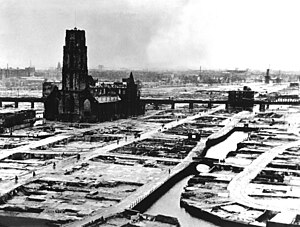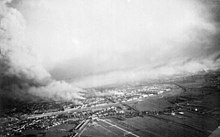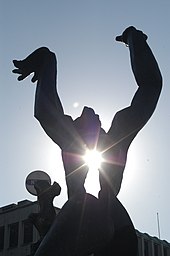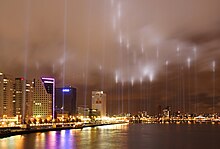German bombing of Rotterdam: Difference between revisions
discuss on talk if you disagree, do not remove without rationale. |
|||
| Line 9: | Line 9: | ||
| place = [[Rotterdam]] |
| place = [[Rotterdam]] |
||
| coordinates = {{Coord|51|57|51.95|N|4|27|4.45|E|region:NL_type:event|display=inline,title}} |
| coordinates = {{Coord|51|57|51.95|N|4|27|4.45|E|region:NL_type:event|display=inline,title}} |
||
| result = |
| result = 884 civilian dead </br>Rotterdam surrenders |
||
|territory = |
|territory = |
||
| combatant1 = {{flagicon|The Netherlands}} [[Netherlands]] |
| combatant1 = {{flagicon|The Netherlands}} [[Netherlands]] |
||
| Line 24: | Line 24: | ||
{{Campaignbox Western Front (World War II)}} |
{{Campaignbox Western Front (World War II)}} |
||
The '''Rotterdam Blitz''' refers to the [[strategic bombing|aerial bombardment]] of [[Rotterdam]] by the [[Luftwaffe|German Air Force]] on 14 May 1940, during the [[Battle of the Netherlands|German invasion of the Netherlands]] in [[World War II]]. The objective was to support the German troops fighting in the city, break Dutch resistance and force the Dutch to surrender. Even though negotiations |
The '''Rotterdam Blitz''' refers to the [[strategic bombing|aerial bombardment]] of [[Rotterdam]] by the [[Luftwaffe|German Air Force]] on 14 May 1940, during the [[Battle of the Netherlands|German invasion of the Netherlands]] in [[World War II]]. The objective was to support the German troops fighting in the city, break Dutch resistance and force the Dutch to surrender. Even though preceding negotiations resulted in a ceasefire, the bombardment took place none the less, in conditions which remain controversial, and destroyed of much of the historic city centre, killing nearly nine hundred civilians and leaving 30,000 people homeless. |
||
==Prelude== |
==Prelude== |
||
| Line 75: | Line 75: | ||
Another bombardment on the city of Rotterdam was on 31 March 1943, US Army Air Forces bombers attacked harbour facilities in the west of Rotterdam. The industrial area between [[Keilehaven]] and [[Merwehaven]] was hit. A combination of strong wind and overcast conditions also caused great damage to the nearby residential areas, especially in the [[Bospolder-Tussendijken]] District. The death toll rose to 401 casualties and around 16,500 people lost their homes. |
Another bombardment on the city of Rotterdam was on 31 March 1943, US Army Air Forces bombers attacked harbour facilities in the west of Rotterdam. The industrial area between [[Keilehaven]] and [[Merwehaven]] was hit. A combination of strong wind and overcast conditions also caused great damage to the nearby residential areas, especially in the [[Bospolder-Tussendijken]] District. The death toll rose to 401 casualties and around 16,500 people lost their homes. |
||
This bombardment was later called the 'Forgotten Bombardment'. Since 31 March 1993 a monument in the Gijsingpark commemorates the victims.<ref>{{nl}}{{en}}[http://www.gemeentearchief.rotterdam.nl/brandgrens/index.php "Rotterdam 40-45 Bombardement en brandgrens"]</ref> |
This bombardment was later called the 'Forgotten Bombardment'. Since 31 March 1993 a monument in the Gijsingpark commemorates the victims.<ref>{{nl}}{{en}}[http://www.gemeentearchief.rotterdam.nl/brandgrens/index.php "Rotterdam 40-45 Bombardement en brandgrens"]</ref> |
||
==Notes== |
==Notes== |
||
| Line 118: | Line 118: | ||
[[Category:Airstrikes]] |
[[Category:Airstrikes]] |
||
[[Category:History of South Holland]] |
[[Category:History of South Holland]] |
||
[[Category:Mass murder in 1940]] |
|||
[[ca:Bombardeig de Rotterdam]] |
[[ca:Bombardeig de Rotterdam]] |
||
Revision as of 15:59, 31 December 2012
| The Rotterdam Blitz | |||||||
|---|---|---|---|---|---|---|---|
| Part of Battle of the Netherlands | |||||||
 Rotterdam's city centre after the bombing. The heavily damaged (now restored) St. Lawrence church stands out as the only remaining building reminiscent of Rotterdam's medieval architecture. | |||||||
| |||||||
| Belligerents | |||||||
|
|
| ||||||
| Commanders and leaders | |||||||
|
| |||||||
The Rotterdam Blitz refers to the aerial bombardment of Rotterdam by the German Air Force on 14 May 1940, during the German invasion of the Netherlands in World War II. The objective was to support the German troops fighting in the city, break Dutch resistance and force the Dutch to surrender. Even though preceding negotiations resulted in a ceasefire, the bombardment took place none the less, in conditions which remain controversial, and destroyed of much of the historic city centre, killing nearly nine hundred civilians and leaving 30,000 people homeless.
Prelude
The Netherlands during the Second World War was strategically lodged between Great Britain and Germany, making it an ideal prospective German air and naval "base" during Operation Sea Lion, the planned invasion of the British Isles that was to follow the forthcoming aerial Battle of Britain. It had firmly opted for neutrality throughout the First World War and had planned to do the same for the Second World War. It most notably refused to accept armaments from France, making the case that they wanted no association with either side. While armament production was slightly increased after the invasion of Denmark in April 1940, the Netherlands possessed 35 modern wheeled armoured fighting vehicle, no tracked armoured fighting vehicles, 135 aircraft and 280,000 soldiers, while Germany had 159 tanks, 1,200 modern aircraft and around 150,000 soldiers at their disposal [for the Dutch theatre only].[1]
With a significant military advantage, Germany prepared to use their 'Blitzkrieg' tactics, by first taking control of key military and strategic targets, such as airfields, bridges and roads and then using these to take over control of the remainder of the country. An invasion of the Netherlands was first made reference to on 9 October 1939, when Hitler ordered that "Preparations should be made for offensive action on the northern flank of the Western Front crossing the area of Luxembourg, Belgium and the Netherlands. This attack must be carried out as soon and as forcefully as possible."[2] Preparation was started when Hitler ordered German army officers to capture Dutch army uniforms and use them to gain inside information on Dutch defence tactics.[3]
Germany finally attacked the Netherlands in the early hours of 10 May 1940. The attack started with the Luftwaffe crossing through Dutch airspace, giving the impression that Britain was the ultimate target. Instead, the aircraft turned around over the North Sea and returned to attack from the west, dropping paratroopers at Valkenburg and Ockenburg airfields, near the Dutch seat of government and the Royal Palace in The Hague, starting the Battle for the Hague. While Germany had planned to take over swiftly using this tactic, the Dutch halted the advance at the core region of Fortress Holland, slowing down the German invasion.
Battle for Rotterdam
The situation in Rotterdam on the morning of 13 May 1940 was a stalemate as it had been over the past three days. Dutch garrison forces under Colonel Scharroo held the north bank of the Nieuwe Maas river, which runs through the city and prevented the Germans from crossing; German forces included airlanding and airborne forces of General Student and newly-arrived ground forces under General Schmidt, based on the 9th Panzer Division and the Leibstandarte Adolf Hitler, a motorized SS regiment.
A Dutch counterattack led by a Dutch marine company had failed to recapture the Willemsbrug traffic bridge,[4][5][6] the key crossing. Several efforts by the Dutch Army Aviation Brigade to destroy the bridge also failed.[7]
On the Morning of 14 May, Hitler issued his "Weisung" Nr. 11. Concerning the Dutch theatre of operations he says the following:
"The resistance capability of the Dutch army has proved to be stronger than expected. Political as well as military reasons demand that this resistance is broken as soon as possible. It is the task of the army to capture the Fortress Holland by committing enough forces from the south, combined with an attack on the east front. In addition to that the air force must, while weakening the forces that up till now have supported the 6th Army, facilitate the rapid fall of the Fortress Holland."
Gen. Schmidt had planned a combined assault the next day, 14 May, using tanks of the 9th Panzer supported by flame throwers, SS troops and combat engineers.[6][8][9][10][11] The airlanding troops were to make an amphibious crossing of the river upstream and then a flank attack through the Kralingen district.[12][13] The attack was to be preceded by artillery bombardment, while Gen. Schmidt had requested the support of the Luftwaffe in the form of a Gruppe (about 25 aircraft) of Ju-87 Stuka dive-bombers, specifically for a precision raid.[14][15][16]
Schmidt's request for air support reached Berlin, staff of Luftflotte 2. Instead of precision bombers, Schmidt got carpet bombing by Heinkel He 111 bombers besides a Gruppe of Stuka's focussing on some strategic targets.[6][17][18][19][20][21]
The bombing

Schmidt used the threat of destruction of the city to attempt to force Colonel Scharroo to surrender the city. Rotterdam, the largest industrial target in the Netherlands and of major strategic importance to the Germans, was to be bombed. Scharroo refused and stretched out negotiations. The start of the air raid had been set for 13:20 [Dutch time, MET – 1 hr 40].[22][23][24]
Schmidt postponed a second ultimatum to 16:20.[25][26] However, just as the Dutch negotiator was crossing the Willemsbrug to relay this information, the drone of bombers was heard: a total of 90 bombers from Kampfgeschwader 54 were sent over the city.[6][17][21][23][27][28]
Student radioed to postpone the planned attack. When the message reached KG 54's command post, the Kommodore, Oberst Walter Lackner, was already approaching Rotterdam and his aircraft had reeled in their long-range aerials. Haze and smoke obscured the target, to ensure that Dutch defences were hit Lackner brought his formation down to 2,300 ft (700 m).[29] German forces on the noordereiland fired flares[30] to prevent friendly fire — after three aircraft of the southern formation had already unloaded, the remaining 24 from the southern bomber formation aborted their attack. The larger formation came from the north-east, out of position to spot red flares launched from the south side of the city, and proceeded with their attack. Fifty-four He 111s dropped low to release 97 tonnes (213,848 lb) of bombs, mostly in the heart of the city.[6][26][27][29][31][32][33][34]

Why the formation had not received the abort order sooner remains controversial. Oberst Lackner of the largest formation claimed that his crews were unable to spot red flares due to bad visibility caused by humidity and dense smoke of burning constructions and subsequently needed to decrease altitude to 2,000 feet.[21] But the red flare, which Lackner failed to see, might have also been used by the Germans to show their location in the city to avoid friendly fire. An official German form designated red as the colour for that purpose.[35]
In total, 1,150 50-kilogram (110 lb) and 158 250-kilogram (550 lb) bombs were dropped, mainly in the residential areas of Kralingen and the medieval city centre. Most of these hit and ignited buildings, resulting in uncontrollable fires that worsened the following days when the wind grew fiercer and the fires emerged into a firestorm.[6][26][27][29][31][32][33][34] Hooton states that bombs ignited vegetable oil tanks on the dockside, which caused fires that spread into the city centre, causing massive devastation.[29] Although exact numbers are not known, nearly 1,000 people were killed and 85,000 made homeless.[36] Around 2.6 square kilometres (1.0 sq mi) of the city was almost levelled. 24,978 homes, 24 churches, 2,320 stores, 775 warehouses and 62 schools were destroyed.[37] Schmidt sent a conciliatory message to the Dutch commander General Winkelman, who surrendered shortly afterwards, at Rijsoord, a village southeast of Rotterdam.[29] The school where the Dutch signed their surrender was later turned into a small museum.
Aftermath


The Dutch military had no effective means of stopping the bombers (the Dutch Air Force had practically ceased to exist and its anti-aircraft guns had been moved to The Hague), so when another similar ultimatum was given in which the Germans threatened to bomb the city of Utrecht, the Dutch government decided to capitulate rather than risk the destruction of another city.[6][38][39] Western news agencies grossly exaggerated the event for propaganda purposes, portraying Rotterdam as a city mercilessly destroyed by terror bombing without regard to civilian life, with 30,000 dead lying under the ruins.[40] The number of casualties 'lying under the ruins' was relatively small, because thousands of civilians had fled to safer parts of Rotterdam, or to other cities, during the previous four days of bombing and warfare.[41] German weekly Die Mühle (The Windmill) stated that the Dutch government was to blame for turning Rotterdam into a fortress, despite multiple summons to evacuate. It also claimed that the old city was ignited by Dutch bombs and incendiary devices.[42]
The United Kingdom had had a policy of only bombing military targets and infrastructure such as ports and railways which were of military importance.[43] While it was acknowledged that bombing of Germany would cause civilian casualties, the British government renounced the deliberate bombing of civilian property, outside combat zones (which after the fall of Poland, meant German areas east of the Rhine) as a military tactic.[44] This policy was abandoned on 15 May 1940, one day after the Rotterdam Blitz, when the RAF was directed to attack targets in the Ruhr, including oil plants and other civilian industrial targets which aided the German war effort, such as blast furnaces that at night were self-illuminating. The first RAF raid on the interior of Germany took place on the night of 15/16 May 1940.[45]
Air raids 1940-1945
After the Luftwaffe bombardment of 14 May the city endured several air raids by allied air forces during the German occupation of the Netherlands. 128 known air raids on Rotterdam and its surroundings were carried out by the RAF and the United States Army Air Forces (USAAF). Around half of these attacks were directed at targets within the city limits of Rotterdam. The rest was mainly aimed at targets near Pernis (petrochemical industries and fuel storage tanks), at the shipyards in Schiedam and the area of the Nieuwe Waterweg. During these air raids 884 people died and 631 people were wounded.
The 'forgotten bombardment,' 31 March 1943
Another bombardment on the city of Rotterdam was on 31 March 1943, US Army Air Forces bombers attacked harbour facilities in the west of Rotterdam. The industrial area between Keilehaven and Merwehaven was hit. A combination of strong wind and overcast conditions also caused great damage to the nearby residential areas, especially in the Bospolder-Tussendijken District. The death toll rose to 401 casualties and around 16,500 people lost their homes.
This bombardment was later called the 'Forgotten Bombardment'. Since 31 March 1993 a monument in the Gijsingpark commemorates the victims.[46]
Notes
- ^ Goossens, War over Holland: The Dutch Struggle May 1940, 2009
- ^ The Nizkor Project, Aggression against Belgium, the Netherlands and Luxembourg, 2008
- ^ Foot, Holland at war against Hitler: Anglo-Dutch relations, 1940-1945, 1990
- ^ E.H. Brongers, (ONR Part III), p. 83
- ^ H. Amersfoort e.a. p. 364
- ^ a b c d e f g Goossens, Allert, Welcome, website of 1998-2009 Stichting Kennispunt Mei 1940, Last updated on 4 August 2009
- ^ E.H. Brongers, (ONR Part I), pp. 242,243
- ^ E.H. Brongers, (ONR Part III), pp. 204, 205
- ^ H. Amersfoort e.a. p. 367
- ^ J.L. van der Pauw. p. 75
- ^ H. Götzel. p. 145
- ^ H. Götzel [page needed]
- ^ Kriegstagebuch, KTB IR.16, 22.ID BA/MA
- ^ E.H. Brongers, (ONR Part III), p. 201
- ^ H. Amersfoort e.a. p. 368
- ^ H. Götzel. pp. 146,147
- ^ a b E.H. Brongers, (ONR Part III), p. 232
- ^ H. Amersfoort e.a. pp. 368,369
- ^ J.L. van der Pauw. p. 74
- ^ H. Götzel, pp. 146–151
- ^ a b c Gen-Lt a.D. Lackner, report BA/MA 1954
- ^ E.H. Brongers, (ONR Part III), p. 235
- ^ a b H. Amersfoort e.a. p. 369
- ^ H. Götzel. pp.149,150
- ^ E.H. Brongers, (ONR Part III), p. 227
- ^ a b c H. Amersfoort e.a. p. 370
- ^ a b c J.L. van der Pauw. p. 84
- ^ Wilhelm Speidel, [page needed]
- ^ a b c d e Hooton, 1994. p. 249
- ^ De Jong, dr. L de, Het Koninkrijk der Nederlanden in de Tweede Wereldoorlog, deel 3 Mei '40 p.352
- ^ a b E.H. Brongers, (ONR Part III), p. 236
- ^ a b H. Götzel, p. 151
- ^ a b Gen-Lt a.D. Lackner, {report BA/MA 1954}
- ^ a b Wagenaar, 1970. p. 307-308
- ^ L. Elfferich, Rotterdam werd verraden. Abcoude: Uniepers, 1990. p. 270
- ^ NOS Nieuws, Veel meer gewonden in mei 1940"
- ^ Van Nul to Nu Deel 3-De vaderlandse geschiedenis van 1815 tot 1940, Page 42 Square 2 – by Thom Roep and Co Loerakker ISBN 90-5425-098-4
- ^ E.H. Brongers, (ONR Part III), p. 263
- ^ H. Amersfoort e.a. p. 183
- ^ Hinchliffe, 2000. p. 43
- ^ Wagenaar, 1970. p. 75-303
- ^ Die Mühle, no.22, 31 May 1940, Moritz Schäfer Verlag, Leipzig
- ^ Hastings 1999, pp. 54–56.
- ^ A.C. Grayling (Bloomsbury 2006), p. 24.
- ^ Taylor, Chapter "Call Me Meier", p. 111
- ^ Template:NlTransclusion error: {{En}} is only for use in File namespace. Use {{langx|en}} or {{in lang|en}} instead."Rotterdam 40-45 Bombardement en brandgrens"
References
- Amersfoort, H. et al. (2005). Mei 1940 - Strijd op Nederlands grondgebied, (in Dutch), SDU, ISBN 90-12-08959-X
- Brongers, E.H. (2004). Opmars naar Rotterdam, (in Dutch), Aspect, ISBN 90-5911-269-5
- Hastings, Max (1999). Bomber Command. London: Pan Books. ISBN 978-0-330-39204-4.
- Götzel, H. (1980). Generaloberst Kurt Student und seine Fallschirmjäger, Podzun-Pallas Verlag, (in German)) ISBN 3-7909-0131-8 OCLC 7863989
- Goossens, Allert, Welcome, website of 1998-2009 Stichting Kennispunt Mei 1940, Last updated on 1 Sept 2010
- [1], website Stichting Kennispunt Mei 1940, article on the raid on Rotterdam [last update 1 Sept 2010].
- Grayling, A. C. (2006). Among the Dead Cities. New York: Walker Publishing Company Inc. ISBN 0-8027-1471-4.
- Hinchcliffe, Peter (1996) The other battle : Luftwaffe night aces versus Bomber Command. Airlife Publishing, ISBN 978-1-85310-547-0
- Hooton, E.R (1994). Phoenix Triumphant; The Rise and Rise of the Luftwaffe. London: Arms & Armour Press. ISBN 1-86019-964-X
- Lackner, a.D. (Gen-Lt) (1953). Bericht Einsatz des KG.54 auf Rotterdam, (in German) Bundesarchiv Militärarchiv Freiburg,
- Nederlands Omroep Stichting (NOS) "Veel meer gewonden in mei 1940." (in Dutch), 10 Dec 2008 Veel meer gewonden in mei 1940
- The Nizkor Project, "Aggression Against Belgium, The Netherlands and Luxembourg." Holocaust Educational Resource. 1991. Aggression Against Belgium, The Netherlands and Luxembourg.
- Spaight. James M. "Bombing Vindicated" G. Bles, 1944. OCLC 1201928 (Spaight was Principal Assistant Secretary of the Air Ministry (U.K)
- Speidel, Wilhelm (General der Flieger). The campaign in Western-Europe 1939-1940, Chief of Staff Luftflotte 2 Western theatre January–October 1940, 1958 – Washington archives, K113-107-152
- Taylor, Frederick. Dresden: Tuesday, 13 February 1945, NY: HarperCollins, ISBN 0-06-000676-5; London: Bloomsbury, ISBN 0-7475-7078-7.
- van der Pauw, J.L. (2006). Rotterdam in de Tweede Wereldoorlog, (in Dutch), Uitgeverij Boom, ISBN 90-8506-160-1
- Wagenaar, Aad (1970). Rotterdam mei '40: De slag, de bommen, de brand, (in Dutch), Amsterdam: De Arbeiderspers, ISBN 90-204-1961-7
- ?. Kriegstagebuch IR.16, May 1940[full citation needed]
Further reading
- Pictures
- Pictures of Rotterdam after the Blitz
- Pictures of the 2007 and 2008 commemoration by Mothership art producers
